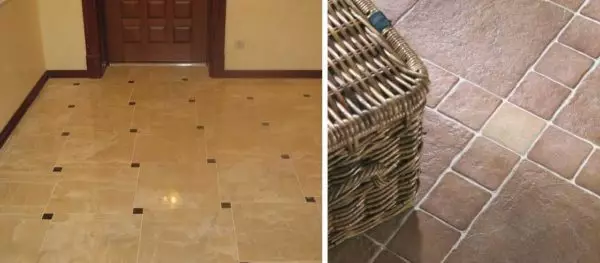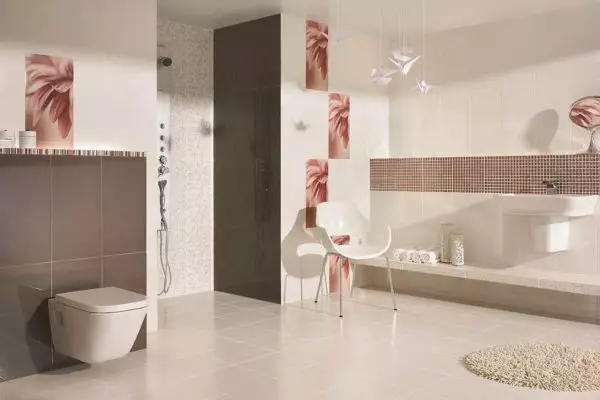Working out the design of the bathroom or design of the kitchen apron is important to determine not only with the color of the finishing materials, but also with their dimensions. When choosing a layout plan, it is important to know which sizes of the tile can be found in the trading network to initially lay out some proportions.
Ceramic tiles for walls
To finish the walls, the tile is released in two formats: rectangular and square. Rectangular can be located with a long side vertically or horizontally. The effect is different. The tile stretched up visually makes the room above, and located horizontally - wider. Both species can be different in size - from small to large.
There are several standard sizes:
- Rectangular tile on the walls: 200 * 300 mm; 250 * 400 mm; 250 * 500 mm;
- Square wall: 100-100 mm, 150 * 150 mm, 200 * 200 mm.

Types and sizes Tile for walls
But there are a lot of non-standard sizes of the tile. For example, there is a large square on the walls - up to 400 * 400 mm. Or long and narrow rectangular - 100 * 300 mm, 200 * 500 mm or 200 * 600 mm. Such sizes of tiles are usually not in bulk collections. When buying non-standard options, take always with some reserve: the author's collections are released with a small circulation. If it is necessary to replace the breaking tel, it may not be on sale.
Tile thickness for walls - from 4 mm to 9 mm. Very subtle suitable for little loaded rooms. The fattest is more often used for the outer decoration of the walls. The optimal thickness of the tile for walls of the bathroom, the kitchen is average from 6-8 mm.
For floors
A thick ceramic tile with a solid protective coating or porcelain tiles are put on the floor. In form it happens:
- Square (standard tile sizes 200 * 200 mm, 300 * 300 mm, 330 * 330 mm, 350 * 350 mm, 400 * 400 mm, 450 * 450 mm);
- rectangular (100 * 200 mm, 150 * 300 mm, 200 * 300 mm, 300 * 400 mm);
- multifaceted (five-, six and octagonal).
In addition to these sizes there are non-standard: less and more. The largest floor may have a side of 600 mm, and rectangles are 20 * 600 mm or even longer. Usually such long and narrow mimic the wooden surface.

The most common types of floor tiles - square and rectangular
The thickness of the ceramic tile for the floor in the standard version is from 8 mm to 11 mm, but there are high strength - up to 25 mm. For private houses, they are used extremely rare, except to lay out the floor in the garage or on the parking lot, under a carport for cars. In general, where high coating strength is needed.
Another type of tile for floor finishing is porcelain. It is mainly produced by squares, and more often - larger. Standard sizes of porcelain stoneware - 200 * 200 mm, 300 * 300 mm, 400 * 400 mm, 450 * 450 mm, 600 * 600 mm. If there are rectangular, then they are long and narrow: 60 * 120 mm - this is the standard and also encounters such sizes: 200 * 400 mm, 200 * 500 mm, 195 * 600 mm, 200 * 800 mm, 200 * 1200 mm, 300 * 1200 mm, 400 * 800 mm, 445 * 900 mm.

Porcelain stoneware - polished and no
The standard thickness of the porcelain is from 8 mm to 14 mm, but there is thin - from 4 mm to 8 mm. Thin porcelain stonewares are usually placed in the technical premises of apartments or private houses. The load here is small and the strength of the material is enough to stand it.
Mosaic
This type of finishing material is made to allocate in a separate category, as it has many specific features and properties. These are pieces of ceramics, glass, porcelain stoneware or natural stone fixed on the grid. It can be used for both wall decoration and walls. It is especially good on curvilinear structures - thanks to small fragments, the surface of any curvature is fitted.

Mosaic - very original finishing material
The tile in the mosaic is used square with a side from 10 to 50 mm. Much less often consisting of rectangles, polyhedra or rounded form. This design author's collections and dimensions there may be a variety of, but usually within these limits 1-5 cm.
Mosaic thickness - from 2 mm to 12 mm. Threeful usually ceramics and glass. They are more often separated by the walls. For laying on the floor, the material is used for greater thickness - it is more resistant to abrasion. There may already be a porcelain stoneware and a stone, and the thickness is from 5 mm and more.
Choosing a tile size
Choose the dimensions of the tile on the walls and the floor is not only in appearance, but by the time how comfortable to work with it. For example, it is hard to label with a large tile. He is heavy, but not this main thing. A large plane is more difficult to set in the right position. Under it requires a perfectly even reason to apply an uniform layer of adhesive, it was possible to immediately put almost smoothly, and small adjustments to make no problem.

With a tile of large sizes is heavier to work, and it looks good in spacious premises
With a tile of small sizes, another problem is a lot of seams. Even with the presence of crosses to withstand them absolutely smooth without experience is problematic. Because of this, laying a small tile moves slower. Because the most running size is medium. It is easy to work with them even to someone who decided to put the tile on the wall or the floor with their own hands for the first time. For small rooms from aesthetic point of view, the middle or small finish is optimal, and large more organically looks in the spacious room.
Article on the topic: Options for finishing windows with their own hands
